PySide6.QtCore.QEasingCurve¶
- class QEasingCurve¶
The
QEasingCurveclass provides easing curves for controlling animation.Details
Warning
This section contains snippets that were automatically translated from C++ to Python and may contain errors.
Easing curves describe a function that controls how the speed of the interpolation between 0 and 1 should be. Easing curves allow transitions from one value to another to appear more natural than a simple constant speed would allow. The
QEasingCurveclass is usually used in conjunction with theQVariantAnimationandQPropertyAnimationclasses but can be used on its own. It is usually used to accelerate the interpolation from zero velocity (ease in) or decelerate to zero velocity (ease out). Ease in and ease out can also be combined in the same easing curve.To calculate the speed of the interpolation, the easing curve provides the function
valueForProgress(), where theprogressargument specifies the progress of the interpolation: 0 is the start value of the interpolation, 1 is the end value of the interpolation. The returned value is the effective progress of the interpolation. If the returned value is the same as the input value for all input values the easing curve is a linear curve. This is the default behaviour.For example,
easing = QEasingCurve(QEasingCurve.InOutQuad) for t in range(0.0, 1.0): qWarning() << "Effective progress" << t << "is" << easing.valueForProgress(t)
will print the effective progress of the interpolation between 0 and 1.
When using a
QPropertyAnimation, the associated easing curve will be used to control the progress of the interpolation between startValue and endValue:animation = QPropertyAnimation() animation.setStartValue(0) animation.setEndValue(1000) animation.setDuration(1000) animation.setEasingCurve(QEasingCurve.InOutQuad)
The ability to set an amplitude, overshoot, or period depends on the
QEasingCurvetype. Amplitude access is available to curves that behave as springs such as elastic and bounce curves. Changing the amplitude changes the height of the curve. Period access is only available to elastic curves and setting a higher period slows the rate of bounce. Only curves that have “boomerang” behaviors such as theInBack,OutBack,InOutBack, andOutInBackhave overshoot settings. These curves will interpolate beyond the end points and return to the end point, acting similar to a boomerang.The Easing Curves Example contains samples of
QEasingCurvetypes and lets you change the curve settings.Synopsis¶
Methods¶
def
__init__()def
addTCBSegment()def
amplitude()def
customType()def
__ne__()def
__eq__()def
overshoot()def
period()def
setAmplitude()def
setCustomType()def
setOvershoot()def
setPeriod()def
setType()def
swap()def
toCubicSpline()def
type()
Note
This documentation may contain snippets that were automatically translated from C++ to Python. We always welcome contributions to the snippet translation. If you see an issue with the translation, you can also let us know by creating a ticket on https:/bugreports.qt.io/projects/PYSIDE
- class Type¶
The type of easing curve.
Constant
Description
QEasingCurve.Type.Linear
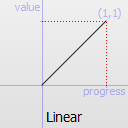
Easing curve for a linear (t) function: velocity is constant.
Constant
Description
QEasingCurve.Type.InQuad
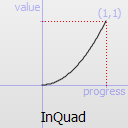
Easing curve for a quadratic (t^2) function: accelerating from zero velocity.
Constant
Description
QEasingCurve.Type.OutQuad
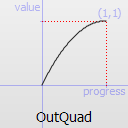
Easing curve for a quadratic (t^2) function: decelerating to zero velocity.
Constant
Description
QEasingCurve.Type.InOutQuad
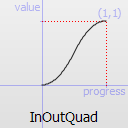
Easing curve for a quadratic (t^2) function: acceleration until halfway, then deceleration.
Constant
Description
QEasingCurve.Type.OutInQuad

Easing curve for a quadratic (t^2) function: deceleration until halfway, then acceleration.
Constant
Description
QEasingCurve.Type.InCubic
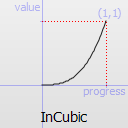
Easing curve for a cubic (t^3) function: accelerating from zero velocity.
Constant
Description
QEasingCurve.Type.OutCubic
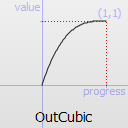
Easing curve for a cubic (t^3) function: decelerating to zero velocity.
Constant
Description
QEasingCurve.Type.InOutCubic
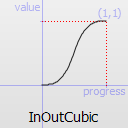
Easing curve for a cubic (t^3) function: acceleration until halfway, then deceleration.
Constant
Description
QEasingCurve.Type.OutInCubic

Easing curve for a cubic (t^3) function: deceleration until halfway, then acceleration.
Constant
Description
QEasingCurve.Type.InQuart
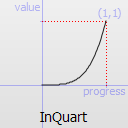
Easing curve for a quartic (t^4) function: accelerating from zero velocity.
Constant
Description
QEasingCurve.Type.OutQuart
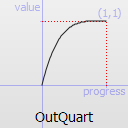
Easing curve for a quartic (t^4) function: decelerating to zero velocity.
Constant
Description
QEasingCurve.Type.InOutQuart
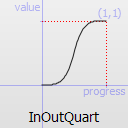
Easing curve for a quartic (t^4) function: acceleration until halfway, then deceleration.
Constant
Description
QEasingCurve.Type.OutInQuart
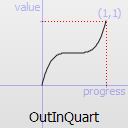
Easing curve for a quartic (t^4) function: deceleration until halfway, then acceleration.
Constant
Description
QEasingCurve.Type.InQuint
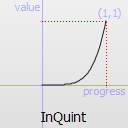
Easing curve for a quintic (t^5) easing in: accelerating from zero velocity.
Constant
Description
QEasingCurve.Type.OutQuint
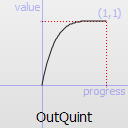
Easing curve for a quintic (t^5) function: decelerating to zero velocity.
Constant
Description
QEasingCurve.Type.InOutQuint
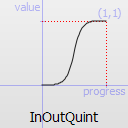
Easing curve for a quintic (t^5) function: acceleration until halfway, then deceleration.
Constant
Description
QEasingCurve.Type.OutInQuint
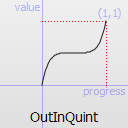
Easing curve for a quintic (t^5) function: deceleration until halfway, then acceleration.
Constant
Description
QEasingCurve.Type.InSine

Easing curve for a sinusoidal (sin(t)) function: accelerating from zero velocity.
Constant
Description
QEasingCurve.Type.OutSine
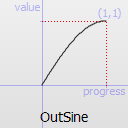
Easing curve for a sinusoidal (sin(t)) function: decelerating to zero velocity.
Constant
Description
QEasingCurve.Type.InOutSine
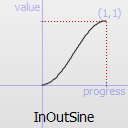
Easing curve for a sinusoidal (sin(t)) function: acceleration until halfway, then deceleration.
Constant
Description
QEasingCurve.Type.OutInSine
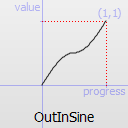
Easing curve for a sinusoidal (sin(t)) function: deceleration until halfway, then acceleration.
Constant
Description
QEasingCurve.Type.InExpo
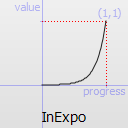
Easing curve for an exponential (2^t) function: accelerating from zero velocity.
Constant
Description
QEasingCurve.Type.OutExpo
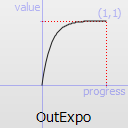
Easing curve for an exponential (2^t) function: decelerating to zero velocity.
Constant
Description
QEasingCurve.Type.InOutExpo
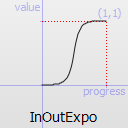
Easing curve for an exponential (2^t) function: acceleration until halfway, then deceleration.
Constant
Description
QEasingCurve.Type.OutInExpo

Easing curve for an exponential (2^t) function: deceleration until halfway, then acceleration.
Constant
Description
QEasingCurve.Type.InCirc
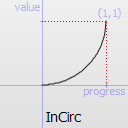
Easing curve for a circular (sqrt(1-t^2)) function: accelerating from zero velocity.
Constant
Description
QEasingCurve.Type.OutCirc
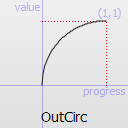
Easing curve for a circular (sqrt(1-t^2)) function: decelerating to zero velocity.
Constant
Description
QEasingCurve.Type.InOutCirc
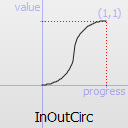
Easing curve for a circular (sqrt(1-t^2)) function: acceleration until halfway, then deceleration.
Constant
Description
QEasingCurve.Type.OutInCirc
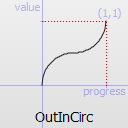
Easing curve for a circular (sqrt(1-t^2)) function: deceleration until halfway, then acceleration.
Constant
Description
QEasingCurve.Type.InElastic

Easing curve for an elastic (exponentially decaying sine wave) function: accelerating from zero velocity. The peak amplitude can be set with the amplitude parameter, and the period of decay by the period parameter.
Constant
Description
QEasingCurve.Type.OutElastic
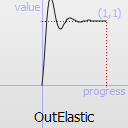
Easing curve for an elastic (exponentially decaying sine wave) function: decelerating to zero velocity. The peak amplitude can be set with the amplitude parameter, and the period of decay by the period parameter.
Constant
Description
QEasingCurve.Type.InOutElastic
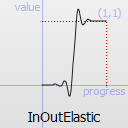
Easing curve for an elastic (exponentially decaying sine wave) function: acceleration until halfway, then deceleration.
Constant
Description
QEasingCurve.Type.OutInElastic
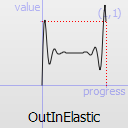
Easing curve for an elastic (exponentially decaying sine wave) function: deceleration until halfway, then acceleration.
Constant
Description
QEasingCurve.Type.InBack
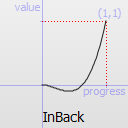
Easing curve for a back (overshooting cubic function: (s+1)*t^3 - s*t^2) easing in: accelerating from zero velocity.
Constant
Description
QEasingCurve.Type.OutBack

Easing curve for a back (overshooting cubic function: (s+1)*t^3 - s*t^2) easing out: decelerating to zero velocity.
Constant
Description
QEasingCurve.Type.InOutBack
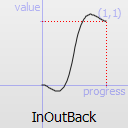
Easing curve for a back (overshooting cubic function: (s+1)*t^3 - s*t^2) easing in/out: acceleration until halfway, then deceleration.
Constant
Description
QEasingCurve.Type.OutInBack

Easing curve for a back (overshooting cubic easing: (s+1)*t^3 - s*t^2) easing out/in: deceleration until halfway, then acceleration.
Constant
Description
QEasingCurve.Type.InBounce
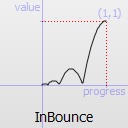
Easing curve for a bounce (exponentially decaying parabolic bounce) function: accelerating from zero velocity.
Constant
Description
QEasingCurve.Type.OutBounce
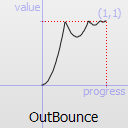
Easing curve for a bounce (exponentially decaying parabolic bounce) function: decelerating from zero velocity.
Constant
Description
QEasingCurve.Type.InOutBounce
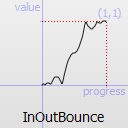
Easing curve for a bounce (exponentially decaying parabolic bounce) function easing in/out: acceleration until halfway, then deceleration.
Constant
Description
QEasingCurve.Type.OutInBounce
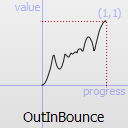
Easing curve for a bounce (exponentially decaying parabolic bounce) function easing out/in: deceleration until halfway, then acceleration.
Constant
Description
QEasingCurve.Type.BezierSpline
Allows defining a custom easing curve using a cubic bezier spline
QEasingCurve.Type.TCBSpline
Allows defining a custom easing curve using a TCB spline
QEasingCurve.Type.Custom
This is returned if the user specified a custom curve type with
setCustomType(). Note that you cannot callsetType()with this value, buttype()can return it.See also
Constructs an easing curve of the given
type.- __init__(other)
- Parameters:
other –
QEasingCurve
Construct a copy of
other.Adds a segment of a cubic bezier spline to define a custom easing curve. It is only applicable if
type()isBezierSpline. Note that the spline implicitly starts at (0.0, 0.0) and has to end at (1.0, 1.0) to be a valid easing curve.c1andc2are the control points used for drawing the curve.endPointis the endpoint of the curve.Adds a segment of a TCB bezier spline to define a custom easing curve. It is only applicable if
type()isTCBSpline. The spline has to start explicitly at (0.0, 0.0) and has to end at (1.0, 1.0) to be a valid easing curve. The tensiontchanges the length of the tangent vector. The continuitycchanges the sharpness in change between the tangents. The biasbchanges the direction of the tangent vector.nextPointis the sample position. All three parameters are valid between -1 and 1 and define the tangent of the control point. If all three parameters are 0 the resulting spline is a Catmull-Rom spline. The begin and endpoint always have a bias of -1 and 1, since the outer tangent is not defined.- amplitude()¶
- Return type:
float
Returns the amplitude. This is not applicable for all curve types. It is only applicable for bounce and elastic curves (curves of
type()InBounce,OutBounce,InOutBounce,OutInBounce,InElastic,OutElastic,InOutElasticorOutInElastic).See also
- customType()¶
- Return type:
object
- __ne__(rhs)¶
- Parameters:
rhs –
QEasingCurve- Return type:
bool
Compares easing curve
lhswithrhsand returnstrueif they are not equal; otherwise returnsfalse. It will also compare the properties of the curves.See also
operator==()- __eq__(rhs)¶
- Parameters:
rhs –
QEasingCurve- Return type:
bool
Compares easing curve
lhswithrhsand returnstrueif they are equal; otherwise returnsfalse. It will also compare the properties of the curves.- overshoot()¶
- Return type:
float
Returns the overshoot. This is not applicable for all curve types. It is only applicable if
type()isInBack,OutBack,InOutBackorOutInBack.See also
- period()¶
- Return type:
float
Returns the period. This is not applicable for all curve types. It is only applicable if
type()isInElastic,OutElastic,InOutElasticorOutInElastic.See also
- setAmplitude(amplitude)¶
- Parameters:
amplitude – float
Sets the amplitude to
amplitude.This will set the amplitude of the bounce or the amplitude of the elastic “spring” effect. The higher the number, the higher the amplitude.
See also
- setCustomType(callable)¶
- Parameters:
callable – object
- setOvershoot(overshoot)¶
- Parameters:
overshoot – float
Sets the overshoot to
overshoot.0 produces no overshoot, and the default value of 1.70158 produces an overshoot of 10 percent.
See also
- setPeriod(period)¶
- Parameters:
period – float
Sets the period to
period. Setting a small period value will give a high frequency of the curve. A large period will give it a small frequency.See also
Sets the type of the easing curve to
type.See also
- swap(other)¶
- Parameters:
other –
QEasingCurve
Swaps this curve with
other. This operation is very fast and never fails.Returns the cubicBezierSpline that defines a custom easing curve. If the easing curve does not have a custom bezier easing curve the list is empty.
Returns the type of the easing curve.
See also
- valueForProgress(progress)¶
- Parameters:
progress – float
- Return type:
float
Return the effective progress for the easing curve at
progress. Whereasprogressmust be between 0 and 1, the returned effective progress can be outside those bounds. For example,InBackwill return negative values in the beginning of the function.